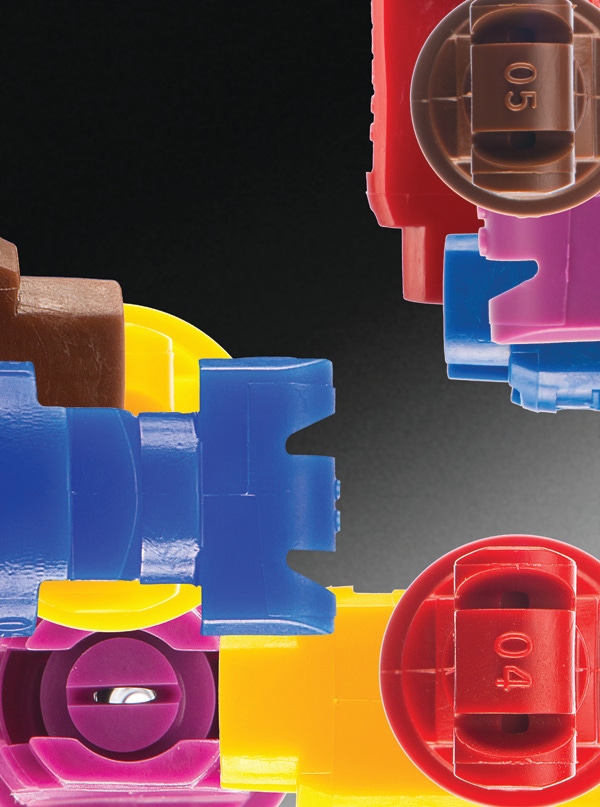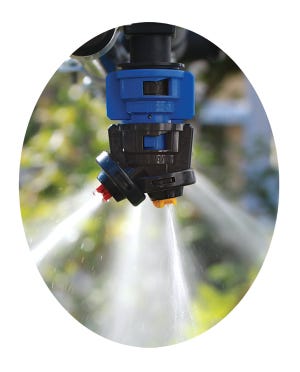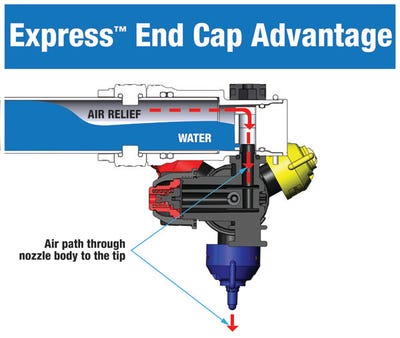February 27, 2013

After years of primarily using one-size-fits-all spray tips that are ideal for spraying Roundup Ready crops, growers may now need to own an arsenal of nozzles specific to a range of chemistries.
“For the last 15 to 20 years, it has been glyphosate, glyphosate, glyphosate, so you were aiming for drift control and big droplet size,” says Tim Stuenkel, global marketing communications manager for TeeJet Technologies. “Today we are entering a time where we are dealing again with a broader range of chemistries for weeds, insects and diseases. It is a new, more complicated world where proper tip selection is becoming more important.”
As a result, some spray tips introduced in the early 2000s that have seen less use in recent times are likely to find their way back onto nozzle turrets, says Gene Schellhorn, spray technology product manager at Hypro. “With weed resistance to glyphosate building up and the reemergence of dicamba and 2,4-D, some of the tips that have been on the market for a few years may have a rebirth. Choosing the right spray tip for your chemical is going to become more critical than ever. The age of forgiving spraying is coming to a close.”
While what is old is becoming new again, both for chemistries and spray tips, manufacturers continue to develop new nozzles, nozzle bodies and related equipment. Here’s a look at the some of the latest innovations designed to maximize product performance, monitor particle size and streamline sprayer operation.
Greenleaf dual fan

The TurboDrop Asymmetric DualFan nozzle, introduced by Greenleaf Technologies in 2011, balances the dual goals of providing excellent coverage and canopy penetration while minimizing drift. The nozzle has an asymmetric spray pattern and dual tip sizes that create a mix of particle sizes that help achieve both goals, says Will Smart, Greenleaf president.
“With the upcoming formulations of glyphosate with dicamba and 2,4-D, there is a lot of talk about droplet size and shifting more to coarser size,” he says. “Coverage also will be critical. With this design, we can create whatever droplet size that you want. You can get enough drift control and coverage at the same time.”
The DualFan nozzle achieves these goals in several ways. It uses two spray tips, with a forward-facing tip oriented at 10 degrees and a rear-facing tip canted at 50 degrees. The forward tip, which is half the size of the rear tip, puts out smaller droplets for improved coverage. The rear-facing tip puts out larger droplets, which surround the smaller droplets as the sprayer moves across the field. This improves penetration, while also reducing drift, Smart says.
Based on field experience, Greenleaf now recommends that every other nozzle should be mounted backwards on the boom, with the rear-facing tip facing forward. This results in four distinct spray patterns delivered to the target, further improving overall performance, Smart says.
In most DualFan sizes, the droplet spectrum is medium-coarse below 80 psi and medium-fine above 80 psi. At 30 to 60 psi, the nozzle provides a droplet size excellent for glyphosate. Smart recommends running the nozzle at 60 psi and above for contact herbicides, fungicides and insecticides.
The suggested retail price for the TurboDrop Asymmetric DualFan nozzle is $15. For more information, contact Greenleaf Technologies, Dept. FIN, 230 E. Gibson St., Covington, LA 70433, 800/881-4832, or visit turbodrop.com.
Hypro Express system

The new Express nozzle body end cap from Hypro practically eliminates air trapped in wet booms, improving on/off boom response times and reducing dribble caused by trapped air.
“When you turn the boom on, the response time is significantly improved,” says Schellhorn, who notes that wet boom systems that are incapable of removing air experience a six- to seven-second lag on average as pressure is gained and released. “Testing has showed improved shutoff times of about 85% with Express nozzle body end caps,” he says.
The Express nozzle body end cap, which includes a nozzle body position, is installed at the ends of 1-in. wet boom sections. Once in place, it channels air that collects on boom high sides through a baffled passageway and out through the end nozzle.
As a result, the spray lag that normally occurs when trapped air is compressed while a boom is being pressurized is practically eliminated. And the dripping that occurs from the time the boom is turned off until the pressure of compressed air falls is nearly eliminated, too, Schellhorn says. Having a nozzle body positioned at the boom ends also reduces the potential for contamination by eliminating boom dead ends.
In 2012, the Express nozzle body end cap, which is available in standard and high-flow versions, was available exclusively on AGCO sprayers. For 2013, availability is unrestricted. The suggested retail price is $46.50 for each end cap.
Hypro has introduced the Push-to-Connect Nozzle Body and FastCap line for liquid fertilizer application on planters and toolbars. The single-position design eliminates threaded fittings and offers the flexibility of using standard spray tip caps or the Push-to-Connect FastCaps. The suggested retail price for each Push-to-Connect Nozzle Body and FastCap is $4.70 to $14.75.
In late 2010, the company also introduced the GuardianAir Twin high-coverage, low-drift air induction spray tip. Its high-coverage forward- and rear-facing fans are designed to help penetrate complex crop canopies requiring thorough coverage, such as when applying insecticides and fungicides. The suggested retail price is $10.25 per nozzle.
For more information, contact Hypro, Dept. FIN, 375 5th Ave. N.W., New Brighton, MN 55112, 800/424-9776, or visit hypropumps.com.
TeeJet real-time monitors

For 2013, TeeJet is taking the guesswork out of droplet-size monitoring with its new Sentry 6120 Droplet Size Monitor. The cab-based touch-screen monitor, which is connected to a boom pressure sensor, shows current operating pressure, as well as the ISO color code for the droplet size.
“A typical self-propelled sprayer can shift droplet sizes dramatically, perhaps two, three or four category sizes, depending on pressure and ground speed,” Stuenkel says. “The sensor keeps people cognizant of what is happening with pressure and droplet size and reminds them of what is important in terms of the product’s mode of action and drift characteristics.”
The monitor doesn’t actually measure droplet size. Instead, it calculates droplet size based on pressure and known attributes of the nozzles being used. The monitor also includes image-based information on tip series and tip capacities to aid in proper nozzle selection. A low- and high-pressure alarm alerts the operator when the system pressure deviates from operator-set limits. The list price of the droplet size monitor is $766.
The Rapid Stop Nozzle Body, an optional feature offered on a number of Quick TeeJet nozzle bodies, also is new. The feature extends the nozzle body inlet tube close to the top inside of the spray boom, which helps evacuate air inside the boom. This results in faster tip shutoff. The suggest retail price is $9.16.
Stuenkel says several TeeJet spray tips introduced in recent years could see more use as crops resistant to dicamba and 2,4-D come on the market. He predicts, for example, that the TTI Turbo TeeJet Induction single flat fan nozzle, the coarsest air induction tip in the TeeJet lineup, could become a dicamba workhorse. The suggested retail price is $7.65. To help operators select the correct spray tip for the job, TeeJet has a free smartphone and tablet computer application, SpraySelect App, available for iPhones, iPads and Android devices.
For more information, contact TeeJet, Dept. FIN, Box 7900, Wheaton, IL 60187, 630/665-5000, or visit teejet.com.
About the Author(s)
You May Also Like






